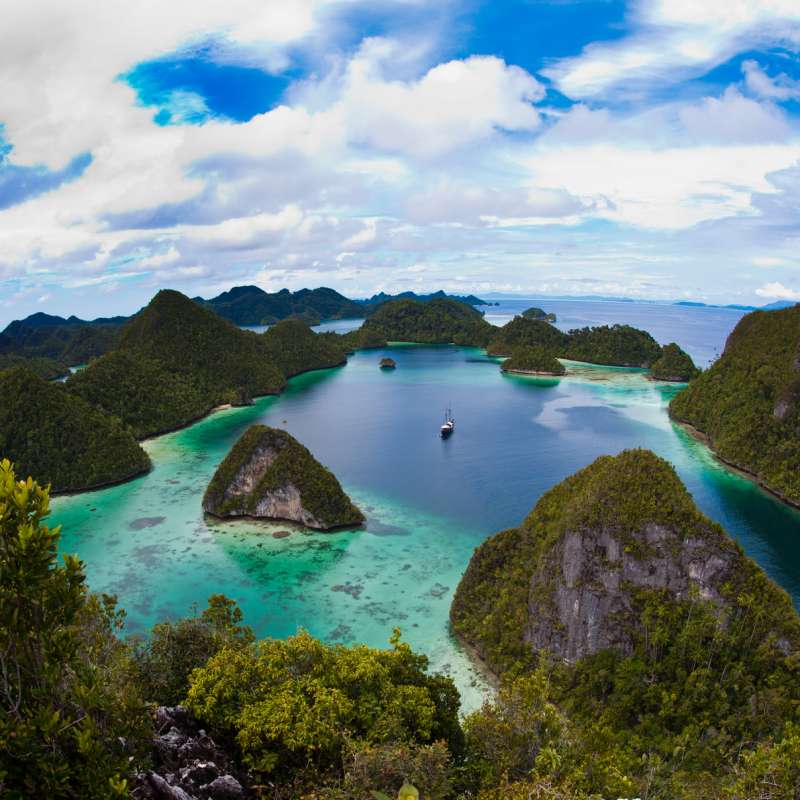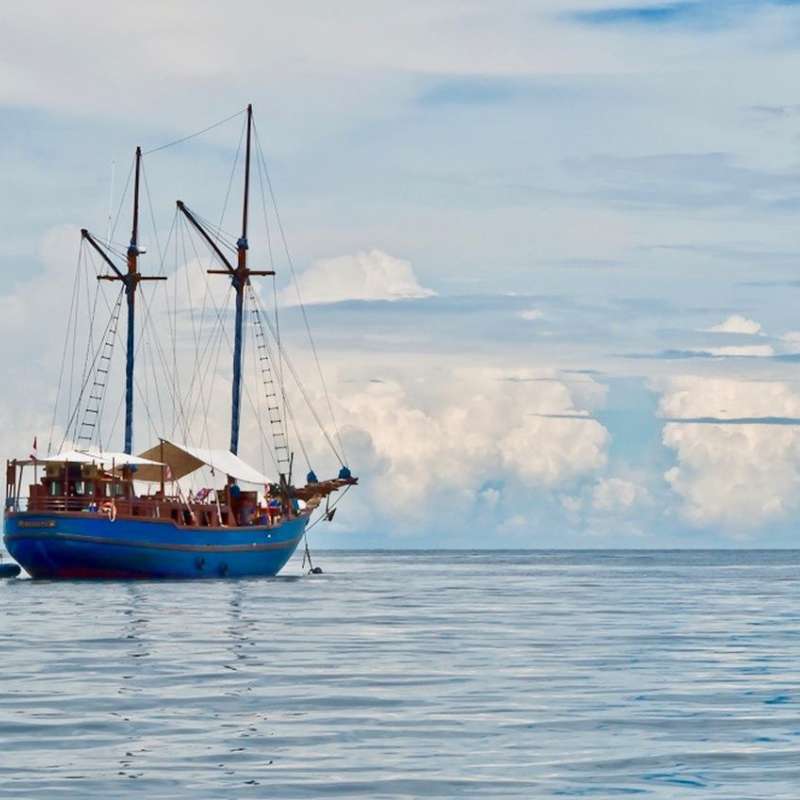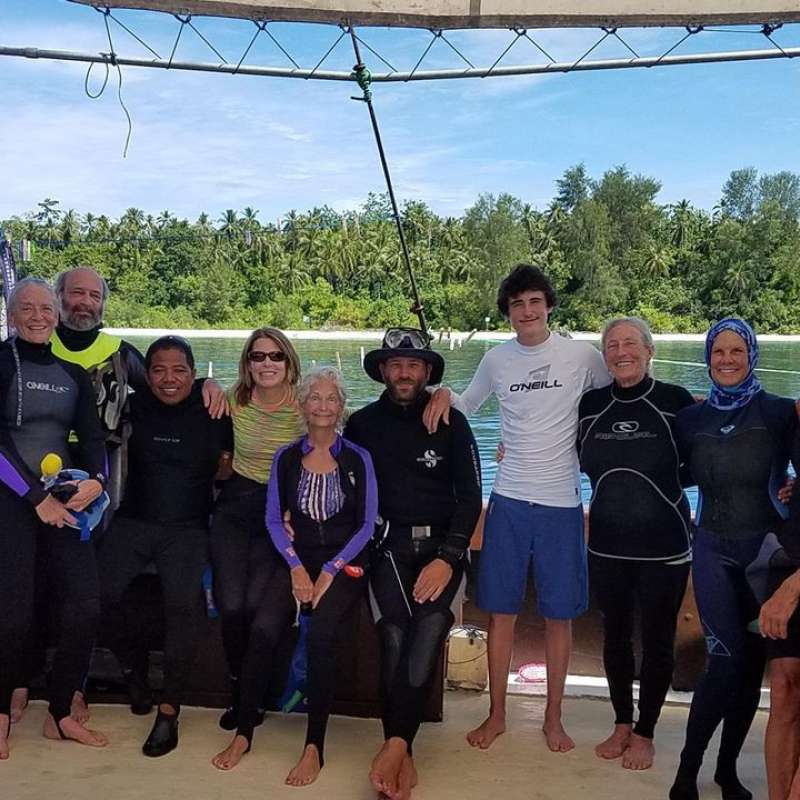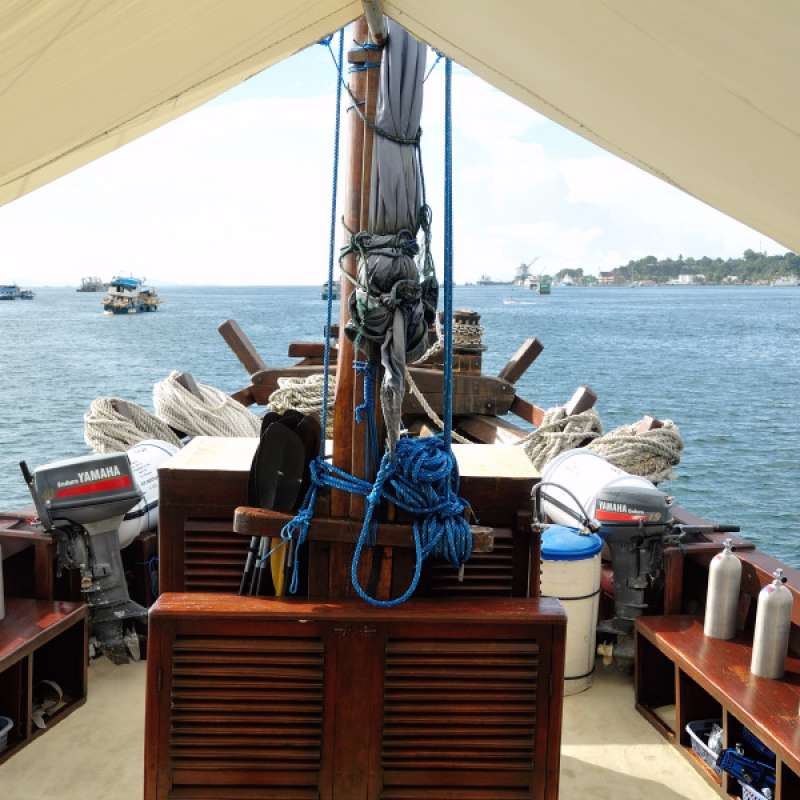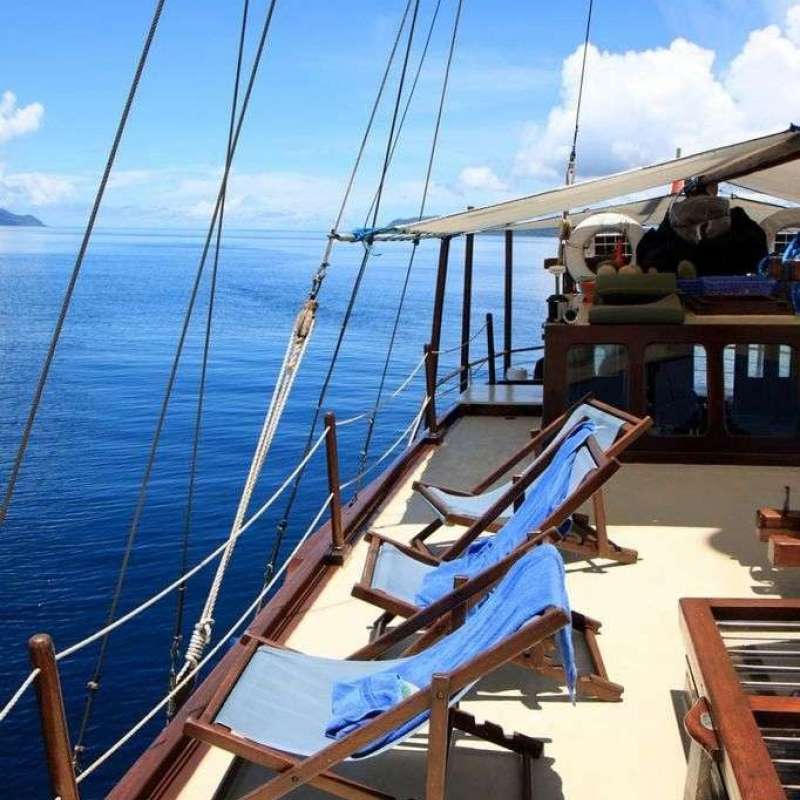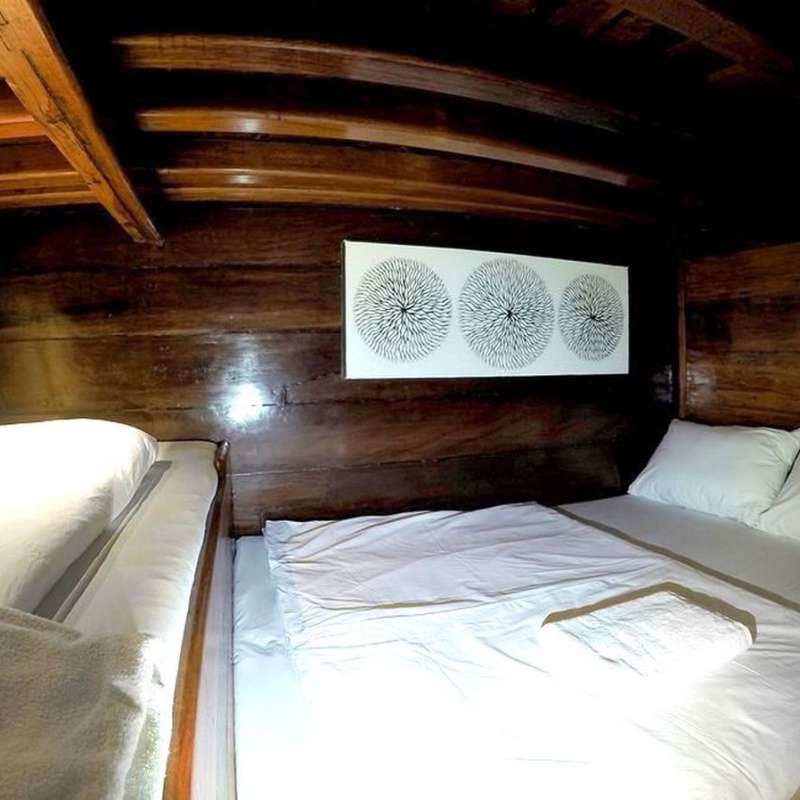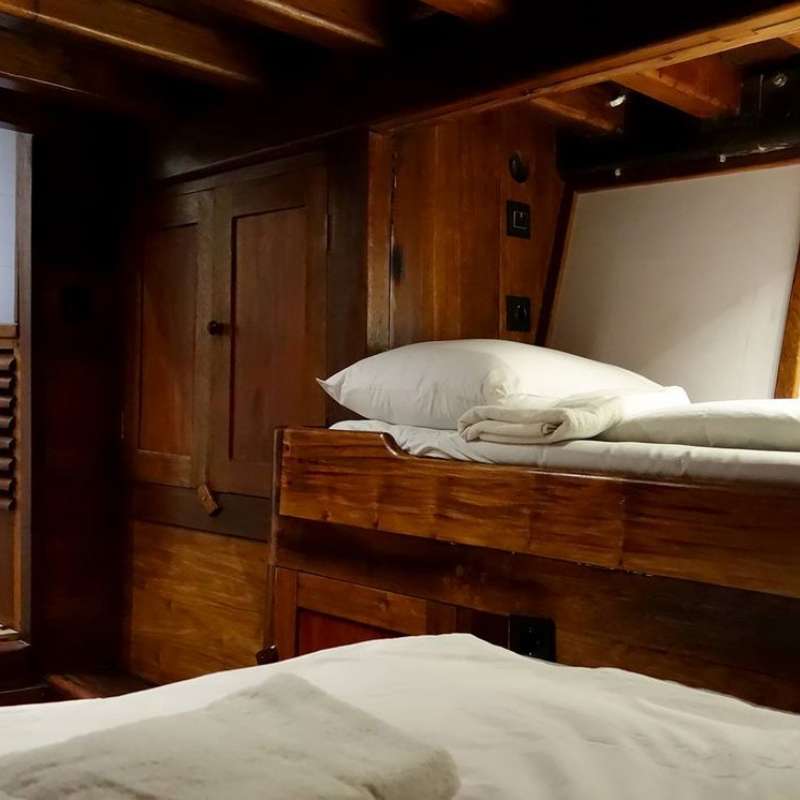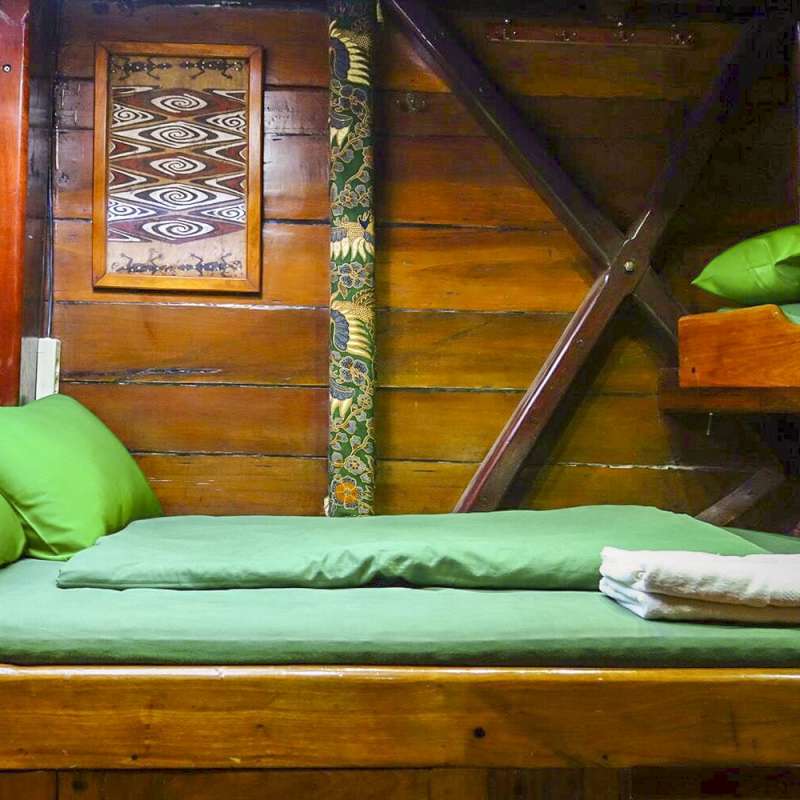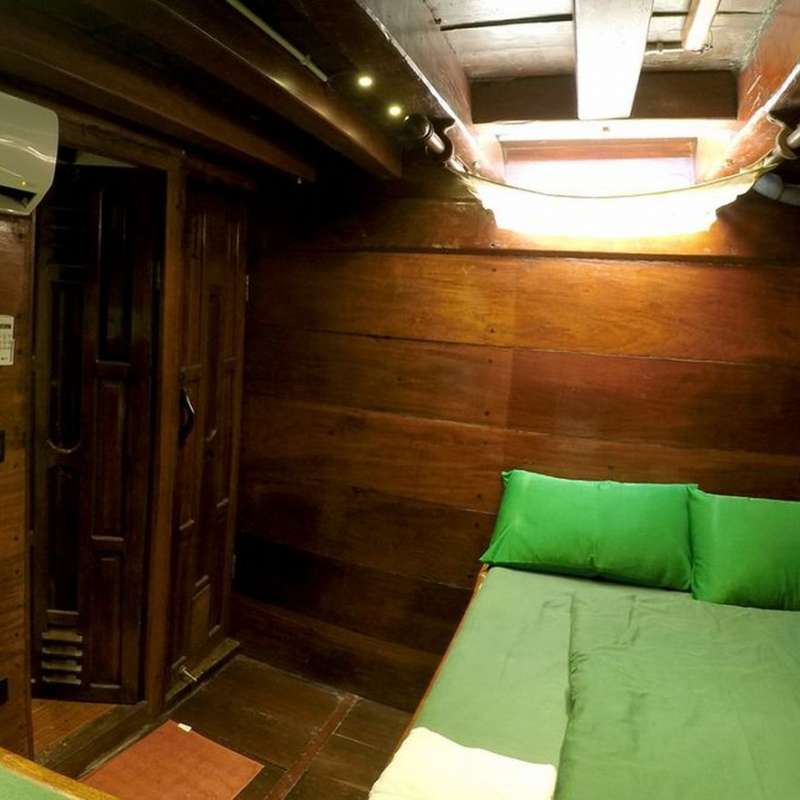Descrizione
Barca
Shakti e' lunga 32 metri e larga 7 ed e' un classico Pinisi Schooner che naviga ad una velocita' di crociera si 7 nodi, costruito a Tanah Beru, un piccolo villaggio a sud est di Makassar. Questo posto ha una lunga e interessante storia nella costruzione di barche con tecniche centenarie e trapassate oralmente tra i maestri d'ascia.
Shakti e' stata costruita da un gruppo di 14 carpentieri insieme all'armatore, il capitano e l'operatore David Pagliari. David ha speso molto tempo pensando ai minimi dettagli per i suoi interni, motori, elettronica...La barca e' stata varata nel 2001.
Shakti e' basata permanentemente a Raj Ampat ed opera due spedizioni mensili di 12 giorni dal 2002, non esiste nessun altra barca che abbia speso tutto questo tempo a Raja Ampat.
Shakti ha uno spazioso salone con aria condizionata ubicato sul ponte inferiore che ha un proiettore per vedere dei film e diverse stazioni di ricarica per gli apparecchi foto/video.
La zona dedicata alla attrezzatura ha punti individuali con ceste, bombole e poi presenti compressori per la ricarica, tre tavoli per le fotocamere e vasche per il risciacquo.
Shakti provvede una colazione continental con pane fresco e gli ospiti possono scegliere il tipo di stile di uova direttamente allo chef. Il pranzo e la cena sono una unione di cucina asiatica ed occidentale a base di pesce, verdure, pollo e manzo. Tra le varie immersioni viene sempre servita una merenda come torte, biscotti...
Shakti e' un'ottima oppurtinita' per affittare privatamente tutta la barca, solo 10 passeggeri, e disegnare con l'esperto team un fantastico itinerario in una delle zone piu' belle al mondo per la sua unica biodiversita'.
Cabine
Shakti ha 6 cabine ed ospita un massimo di 10 passeggeri.
Tutte le cabine hanno aria condizionata, guardaroba e condividono 3 bagni con doccia.
4 Cabine matrimoniali/doppie:1 letto matrimoniale, 1 singolo a castello ed ubicate sul ponte inferiore.
2 Cabine singole: 1 letto matrimoniale ed ubicate sul ponte superiore.
Immersioni
3 immersioni al giorno, dipende dalla rotta e dalla condizioni meteo.
1 o 2 immersioni il giorno prima della partenza.
Nessuna immersione il giorno dell'arrivo e della partenza.
Tutte le immersioni sono guidate da guide professioniste.
Altre informazioni
- Nitrox: Non disponibile.
- Bombola 15L: Prezzi su richiesta e bisogna prenotare in anticipo.
- Affitto Attrezzatura: Prezzi su richiesta e bisogna prenotare in anticipo.
- Assicurazione Subacquea:Obbligatoria.
- Assicurazione Viaggio : Consigliata.
- Wi-Fi Internet: No.
- Pagamento a bordo: In contanti (USD/Euro/IDR).
- Mancia all'equipaggio: Non inclusa, da dare in base alla propria soddisfazione.
Itinerari (V.O)
What Shakti Offering ...
January – early July
Second half of July –> End of August : South Monsoon, Shakti’s maintenance period.
September – January
February -> North Monsoon : Perfect for Misool (south Raja Ampat) itineraries.
July – August
During this period we often organise trips to Cenderawasih Bay which is protected from the Monsoon and has some spectacular indigenous whaleshark populations as well as a large aray of second world war wrecks which we dive on.
Diving Highlights
Penemu: Limestone Islands covered in Tropical Rainforest seam to put you back to a land beyond our time.
Diving: pretty walls with lots of critters and well coral covered slopes, medium current. Excellent night dive sites: interesting species of clams, sea urchins, cephalopods, sea spiders and crabs in current protected areas.
Waigeo/Gam: Waigeo is the biggest of the 4 main islands in Raja Ampat and it’s in thick rainforest covered coasts invite to explore it via kayaks. Beautiful anchorages filled with bird noises at sunrise and sunset will knock you off your feet. The very close island of Gam is the only island in the world where the Red bird of Paradise is found.
Diving: Pinnacles, sandy slopes but also steep valleys inbetween islets, in soft coral covered walls with a hard coral reef top. Pegmy Seahorses, Epaulette sharks and rare nudibranches are some of the highlights here, but some ‘biggies’ are often seen cruising by.
Wayag: This island group is one of the most beautiful ones in the Archipelago. The Geology looks a lot like in Palau - turquoise, clear waters gets washed through the shallow waters directly from the Pacific Ocean. Taking the kayaks out you will see parrots, king fishers and also wild orchids and such around the uncountable mushroom shaped cast limestone rocks. A maze of large forested islands and sizable domes or beehive-shaped islets sourround the shallow lagoons.
Diving: Strong current around pinnacles and rocky islets invite big schools of barakudas and tunas to cruise around this area. Overhanging Walls inhabit lots of critters, also big groupers sharks are seen.
Kabui Passage: The islands Waigeo and Gam are divided by a narrow channel, which is nearly one nautic mile long. Reflected by the thick forests the water looks mystic green and in this peaceful area you can hear a huge amount of jungle noises like birds and bugs.
Diving: The Kabui passage is a very special dive and full of surprises… Strong currents wash through the shallow channel and the greenish water easily seams a bit spooky. Mangroves and rainforest cover its shoreline and inhabit archor fishes and colorful soft corals in the shallow waters but also lots of weird looking critters and juvenile fishes. From time to time you also see turtles and small schools of great barakudas cruising by. Also abnormous sized sponges and all different kinds of sea fans, sea pens, hydroids, sea squirts and shrimps make this area to a very unique habitat.
Daram/Efpian: From the surface the islets of black rock seam almost lost – the only habitats above the water level are pelagic birds, snails and chitons. But the clear deep blue water around them is full of marine life:
Diving: Colorful soft corals and black corals cover the rocks and in the numberous sea fans you find pegmy seahorses and spider crabs. Thousands of little reef fishes add one more dimension to this amazing under water landscape. Often big schools of batfish, bannerfish or red tooth trigger fish are cruising by.
Farondi/Wagmab: Pretty bays and cast limestone islands build the coastline of this region. There are also some interesting caves above and below the water level. Scenbic forested islands hills rise steeply up from the coast.
Diving: Heavy currents make some of the dive sites in between Farondi and Wagmab challenging, but if the visibility is good it is one of the most various and stunning dives you can do. Caves, sandy slopes covered in black coral bushes, gorgonion fans, sea whips etc. Also big schools of barakudas and bumphead parrotfishes are seen on the sites.
Kri/Mansuar: This locations in the centre of Raja Ampat support a diverse reef biota due to its incorporation of several major habits including an exposed steep drop off, algal ridge, reef flat and sheltered lagoons. White sand beaches with palm trees are found all around Mansuar, this area is also very nice for snorkeling.
Diving: Healthy reefs and a huge amount of fish – medium to strong current. Possibility to see Mantas, Blacktip, Whitetip and Grey Reef sharks.
Of course this is only an idea of what you will be seeing when diving in Raja Ampat. Surprise species are found ever again between all those marvellous islands and give new reason to return ever again.
Altro
| Destinazioni | Raja Ampat, Baia di Cenderawasih |
|---|---|
| Disponibili a bordo | Supporto Nitrox, Sidemount Friendly, Watersport equipment, Camera Station |
| Lingue parlate a bordo | English, German |
Orari & percorsi
PREZZI E CONDIZIONI
Incluso
- Trasferimenti dall'aeroporto e/o dall'hotel allo yacht
- IVA e imposte locali
- Pensione intera, Snack / Spuntini
- Acqua minerale, Tè e caffè
- Bibita analcolica
- Attività subacquea (incl. Cilindri, cinghia e pesi)
- Dive guide service
- Uso di Kayak e/o SUP
- Land excursions and activities throughout the trip
- Boat accident insurance
- Teli cabina e set di cortesia
- Servizio di pulizia della cabina
Non incluso
- Domestic flights in destination country
- Tasse del parco marino / Tasse portuali
- Supplemento carburante
- Bevande alcoliche
- Noleggio attrezzatura subacquea
- Larger tank (15 L)
- Immersioni nitrox
- Assicurazione subacquea (requisito obbligatorio)
- Travel insurance (trip cancellation insurance)
- Mancia dell'equipaggio
INFORMAZIONI UTILI
Raja Ampat
Periodo : La stagione per le crociere e' tutto l'anno. La migliore stagione e' da dicembre a marzo con la miglior visibilita'. Molte barche evitano Raja Ampat da meta' luglio a meta' settembre a causa della probabilita' di trovare forte vento con onde e pioggia.
Visto : Per la maggior parte dei paesi viene rilasciato all'arrivo in aeroporto un visto d'ingresso valido 30 al costo di 35 US$ da pagare in contanti. Contattate l'ambasciata o consolato piu' vicino per maggiori informazioni.
Clima : Raja Ampat si trova all'equatore ed ha un clima caldo ed umido. La temperatura dell'aria e' costante con 31 gradi di massima il giorno e 24 gradi la notte, l'umidita' media e' dell'83%.
Acqua : La temperatura dell'acqua e' abbastanza costante e calda tra i 27 e 29 gradi.
Abbigliamento : Vestiti leggeri e che vi protegga dai raggi solari ed una giacca a vento nel caso di pioggia e per la sera.
Spine: Tipo C Europlug, 230V @ 50Hz
Voli : La citta' di Sorong in Papua Occidentale e' la porta d'ingresso per Raja Ampat, i voli arrivano da Jakarta, Depansar, Bali e Makassar.
Tasse aeroportuali: Alla partenza sono applicate ad ogni aeroporto indonesiano. Queste tasse devono essere pagate in contanti in Rupia indonesiana (IDR). Le tasse per partenze nazionali variano tra 20,000-40,000 IDR a persona. Negli aeroporti internazionali le tasse sono pi˘ alte, tra 100,000-150,000 IDR a persona. - Si prega di notare che la franchigia bagaglio su tutti i voli nazionali e' limitata a 15 kg per una sola persona e qualsiasi chilo aggiuntivo sar‡ soggetto a supplemento.
Valuta: La moneta ufficiale Ë la Rupia indonesiana (IDR), i cambi si possono trovare nella maggior parte dei posti. Ci sono Bancomat Internazionali (Visa / Masterd carta / Unionpay) e le Carte di credito non sono sempre accettate, alcuni importi possono essere solo pagati in contanti.
Baia di Cenderawasih
Best time for diving
Mid June to early November, diving is possible year-round, the plankton bloom usually happens between September and early April which attract the whale sharks even more, but you can see them in the bay year round. Liveaboards usually offer trips in Cenderawasih bay when other Indonesian sites are affected by inclement weather between June to October. Visibility can be between 10 - 35 meters here with mild currents.
About temperatures
Air : generally ranges between 25°C - 32°C year-round.
Sea : it is warm all year round, about 27°C - 30°C
Wetsuit Recommendation
We recommend a 3 mm full wetsuit throughout the year.
Diver requirement
Suitable for all levels. You can find out more informations about diving in Cenderawasih bay here : Cenderawasih bay
Embarkation / Disembarkation
Depending on which itinerary you choose, the embarkation / disembarkation can be in Manokwari (MKW), Nabire (NBX), Biak (BIK). The international airport with the best connections is Jakarta (CGK).
However, some liveaboard trips will combine Cenderawasih bay with other destinations like Raja Ampat, then the embarkation and disembarkation will be different. So please ask our agent to know the exact port for your trip.
Visa Requirements
Indonesia offers a free visa on arrival service for many nationalities which allows visitors to stay in the country for up to 30 days. A list of countries that are eligible for visa on arrival can be found on the Indonesian Government's Directorate General of Immigration.
Please note: Immigration officials in Indonesia may ask for proof of onward travel (e.g. a return or onward air ticket).
Vaccinations
Yellow fever vaccination certificate is required for travellers over the age of 9 months arriving from countries with risk of yellow fever transmission.
Money Matters
The local currency is Indonesian Rupiah (IDR), all liveaboards accept cash payments in USD.
Rupiah can be purchased from all major banks and exchange outlets. Credit and debit cards are also accepted in major hotels, restaurants & shops.
Drones
There are very few restrictions on the use of drones for photography purposes within Indonesia. Please check Drone laws in Indonesia for details.
Extending your holiday
We offer a range of hotels/resorts, land-based diving packages, and excursions that can be arranged before or after your liveaboard holiday. Just ask us if you need such service.
Recensioni dei Sub (1)



